Golden Camellia (Camellia petelotii (Merr.) Sealy) is a woody plant belonging to the family Theaceae and the genus Camellia. The young branches are light brown, and the small branches of the current year have a slight purplish-brown color, without hairs.
The leaves are leathery, dark green and shiny on the upper surface, hairless, and light green on the lower surface. The petals are golden yellow and fleshy.
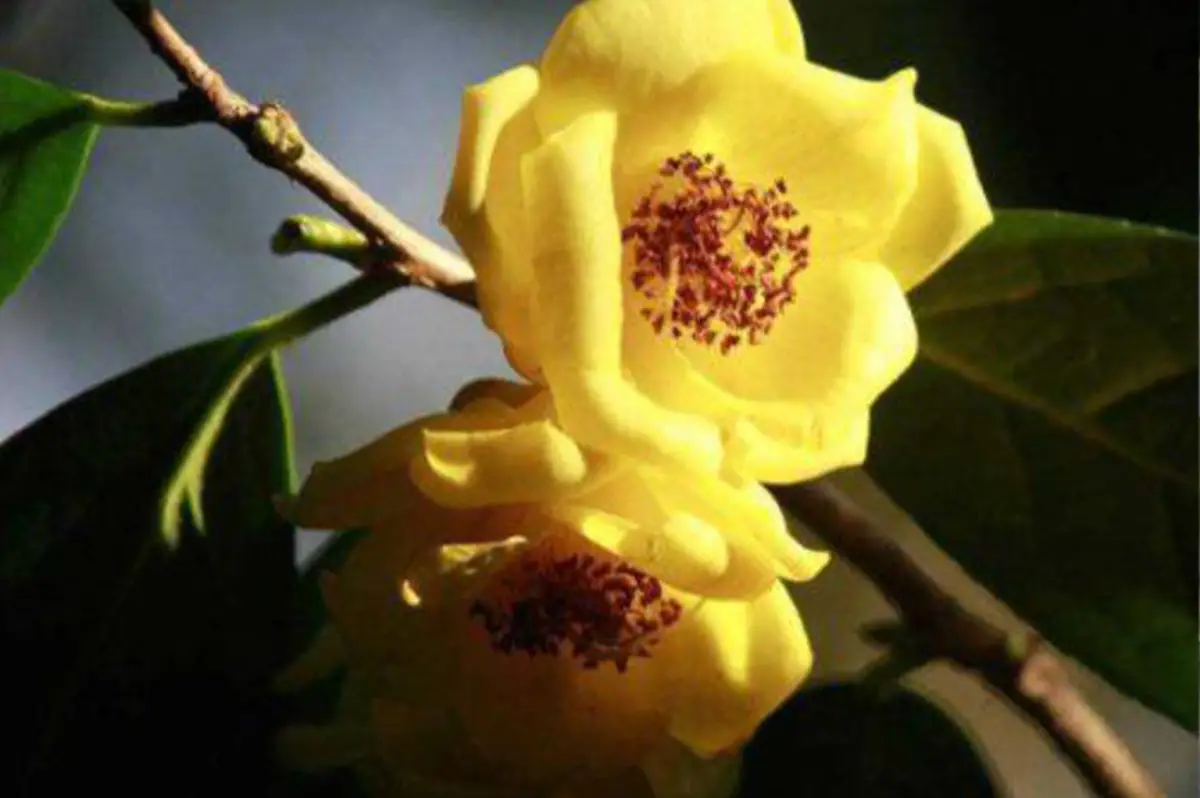
The fruit is flattened and slightly concave at the apex. The seeds are brown and semi-spherical. The flowering period is from November to December. Golden Camellia gets its name from its pure yellow flowers resembling gold.
Golden Camellia is a unique variety of tea flower in China and is known as the “Queen of Tea Flowers.” It is distributed in Guangxi, Guangdong, and other regions.
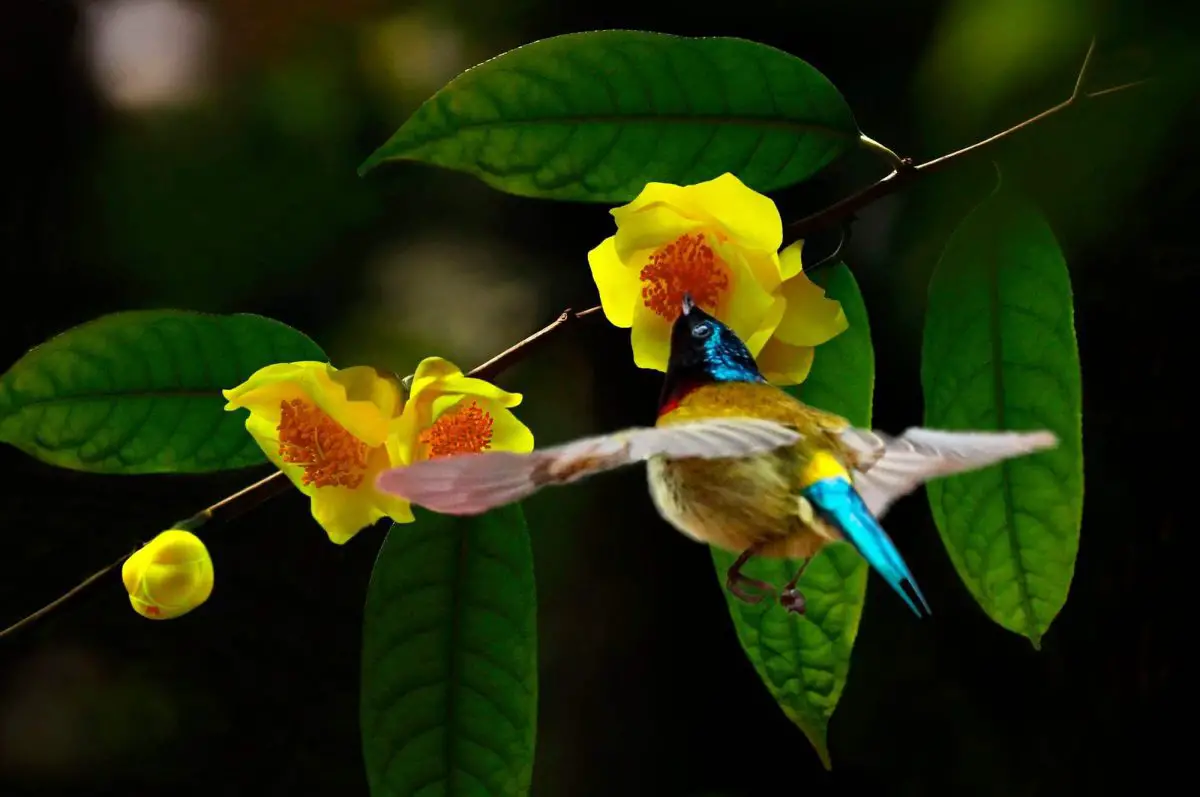
It prefers a warm and humid climate, tolerates poor and infertile soil, has strong resistance to waterlogging, and prefers shade during the seedling stage.
After entering the flowering period, it thrives when exposed to sunlight. It can grow in loosely textured and well-drained low-altitude hilly terraces with a wide range of soil types, from slightly acidic to neutral. Golden Camellia can be propagated through sowing, grafting, cutting, and layering.

According to the “Standards for Chinese Medicinal Materials in Guangxi,” Golden Camellia has the function of astringing and stopping bleeding. It is mainly used to treat conditions such as bloody stools, excessive menstruation, and unceasing dripping.
The flower buds of Golden Camellia are round and radiant, making them highly ornamental. The wood of Golden Camellia is hard and dense, making it a good material for carving and handicrafts.
It can also be used to produce natural edible dyes. In addition to being used for brewing tea and beverages, the leaves can be used to treat mental disorders and ulcers. Furthermore, the seeds can be pressed for oil, used as food, or serve as raw materials for industrial lubricants and other solvents.
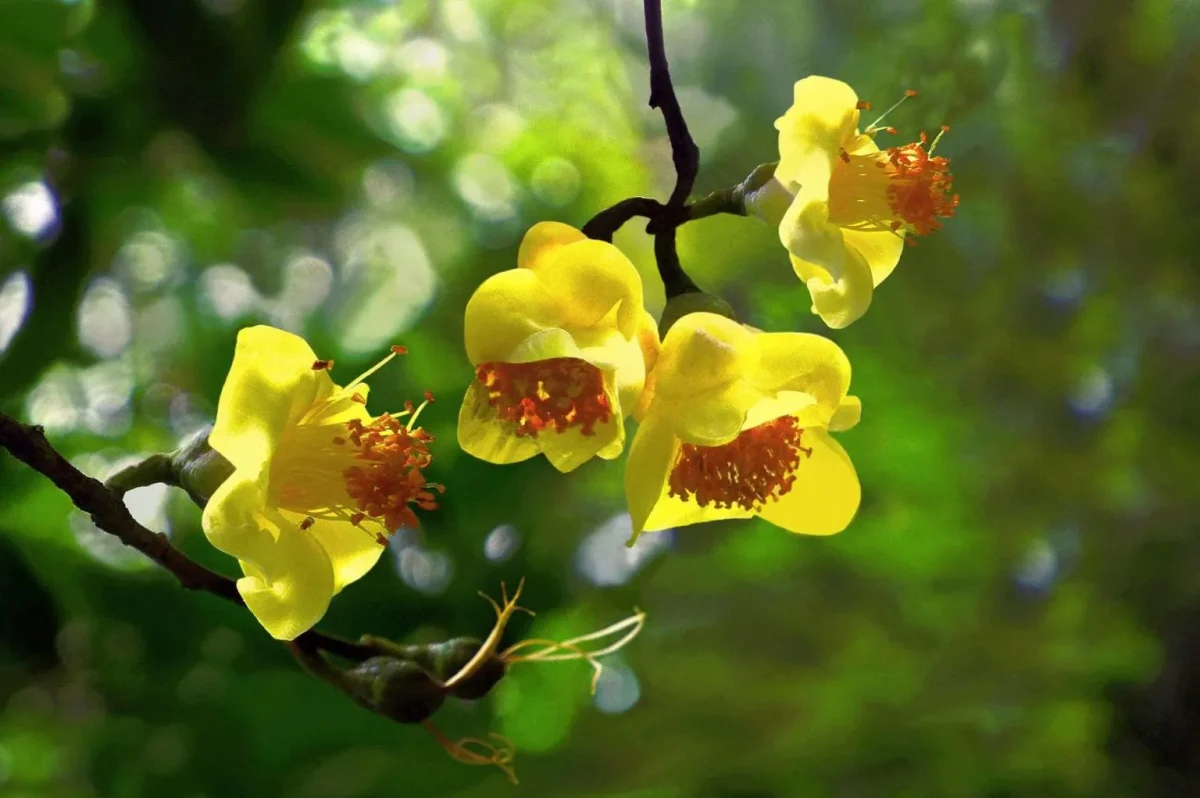
Golden Camellia is named for its pure yellow flowers that resemble gold.
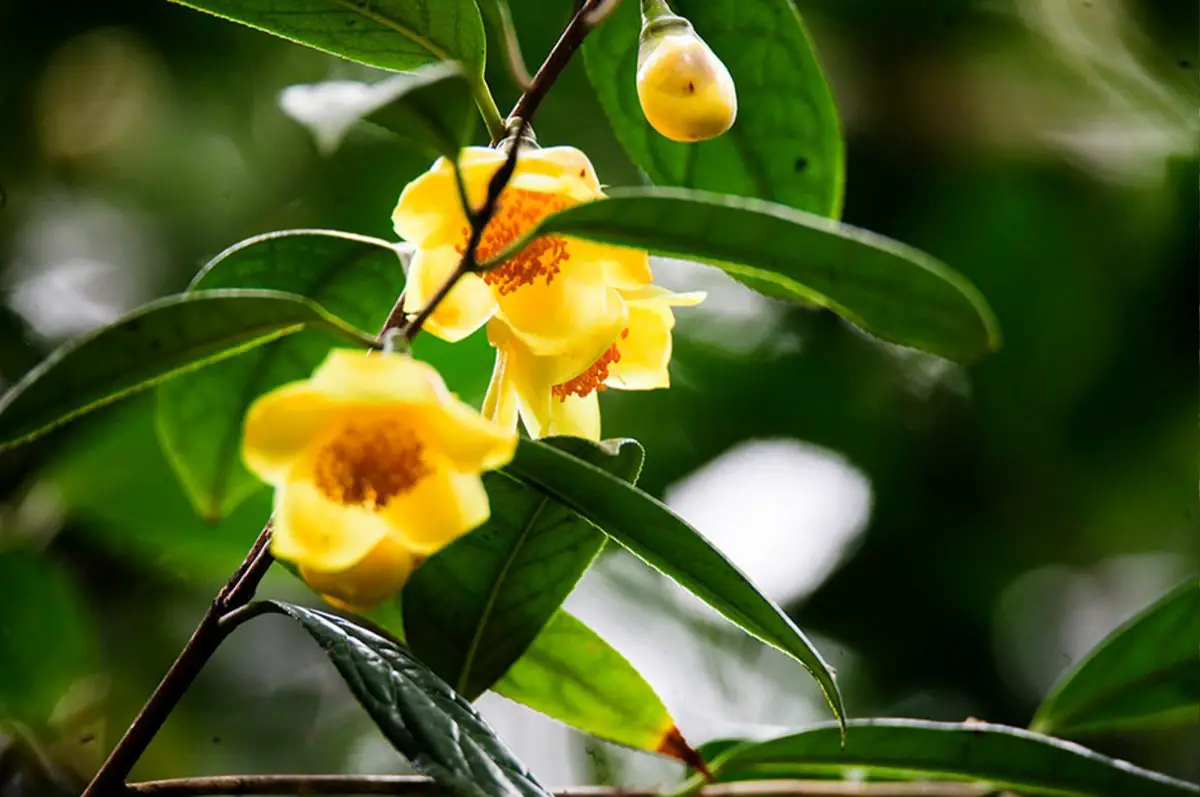
Shrub, reaching a height of 2 to 3 meters, with smooth young branches. The leaves are leathery, elongated or lanceolate, or inversely lanceolate, measuring 11 to 16 centimeters in length and 2.5 to 4.5 centimeters in width.
They have a tapering pointed tip, a wedge-shaped base, and a glossy dark green upper surface without hairs. The lower surface is light green, hairless, with black glandular dots. There are 7 pairs of veins, slightly depressed on the upper surface and raised on the lower surface.
The leaf margin is finely serrated with tooth intervals of 1 to 2 millimeters. The leaf stalk is 7 to 11 millimeters long and hairless.
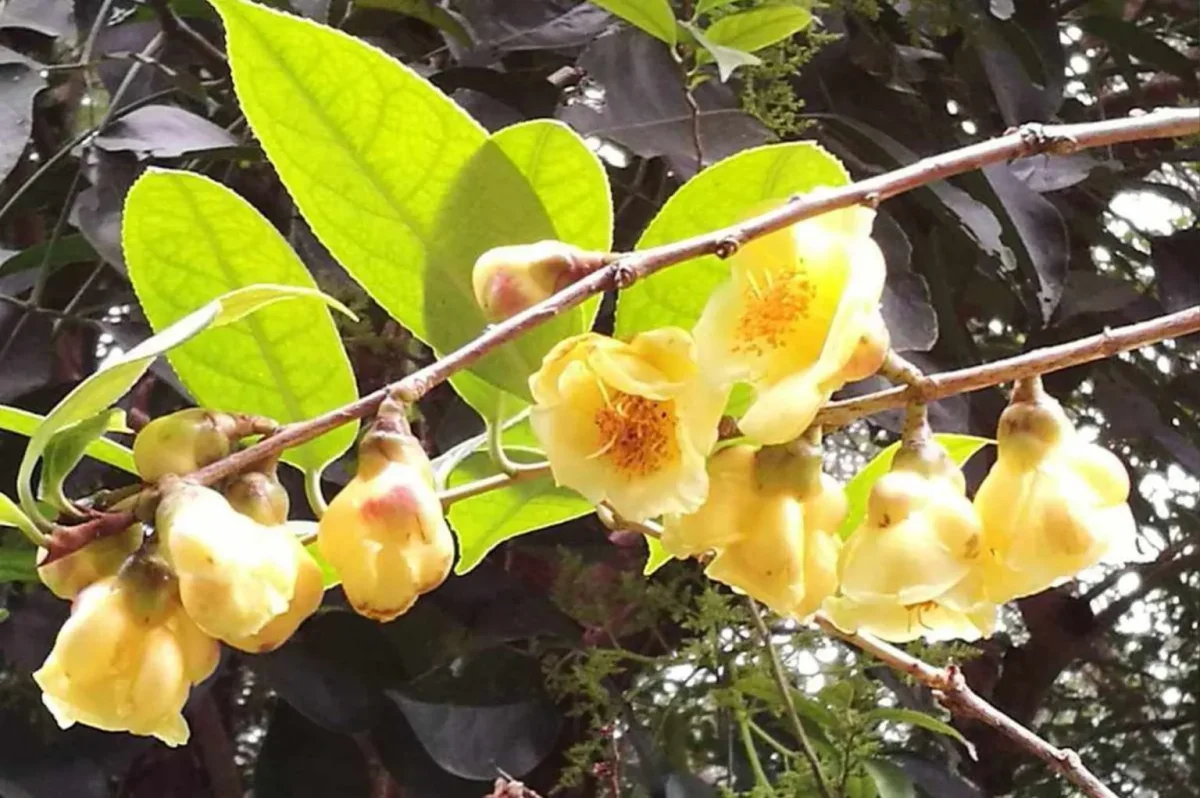
The flowers are yellow, axillary, solitary, with flower stalks measuring 7 to 10 millimeters in length. The sepals are 5 in number, scattered, broadly ovate, measuring 2 to 3 millimeters in length and 3 to 5 millimeters in width, persistent.
The petals are 8 to 12 in number, nearly circular, measuring 1.5 to 3 centimeters in length and 1.2 to 2 centimeters in width, slightly connate at the base, with ciliate margins. The stamens are arranged in 4 whorls, with the outer whorl slightly connate with the petals.
The filaments are nearly free or slightly fused, hairless, measuring 1.2 centimeters in length. The ovary is hairless, 3 to 4-loculed, and bears 3 to 4 styles, hairless, measuring 1.8 centimeters in length.
The capsule is flattened, triangular-spherical, measuring 3.5 centimeters in length and 4.5 centimeters in width. It splits into 3 valves, with each valve being 4 to 7 millimeters thick. The central axis is 3 to 4-angled and splits into 3 to 4 lobes at the apex.
The fruit stalk is 1 centimeter long and bears persistent bracts and sepals. There are 6 to 8 seeds, each measuring approximately 2 centimeters in length. The flowering period is from November to December.
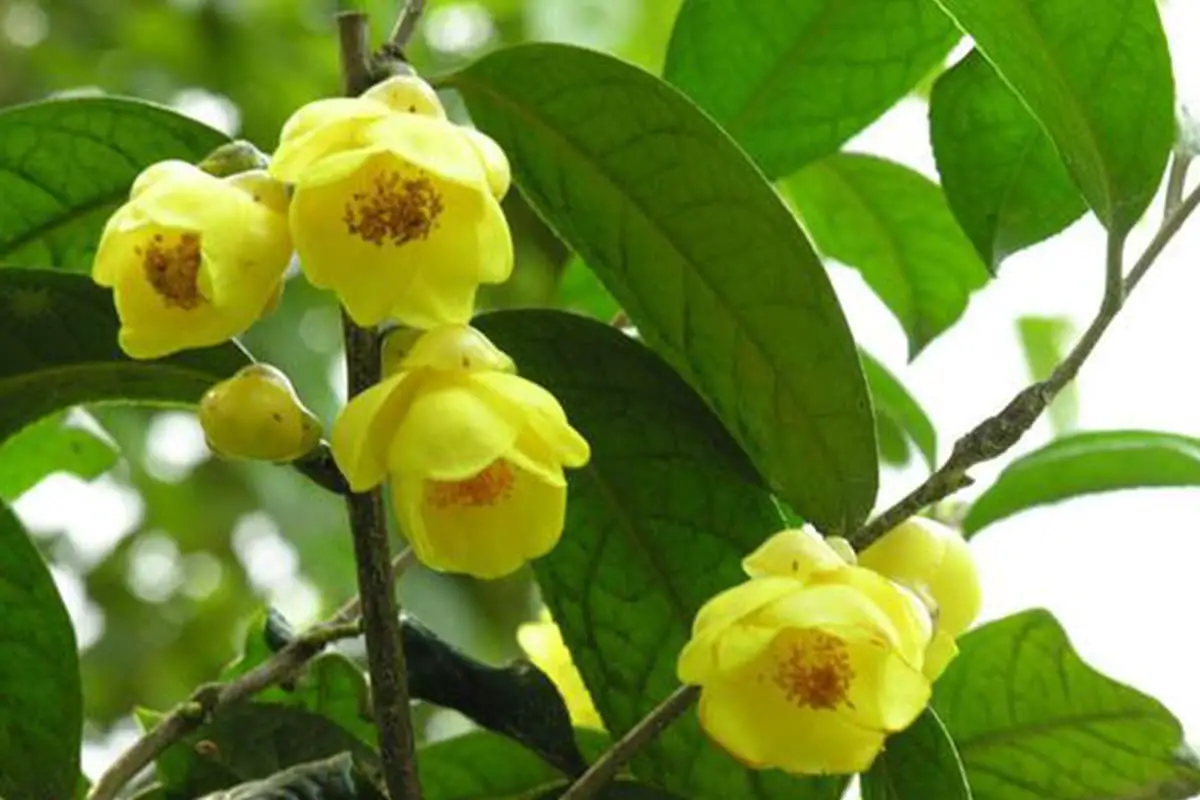
Golden Camellia, also known as “Tea Queen,” is a unique variety of camellia flower in China. It is mainly found in Guangxi and Guangdong provinces. Golden Camellia is an ancient and extremely rare plant with a very narrow distribution.
Approximately 90% of the wild Golden Camellia in the world is found only in the Lan Mountain branch of Shiwandashan in Fangchenggang City, Guangxi, China. It grows at an elevation below 700 meters, with the range between 200 and 500 meters being more common. The lower limit of its vertical distribution is around 20 meters above sea level.
There are still some populations of Golden Camellia found in the coastal hilly terrains near the Dawang River in Fangcheng County. The upper limit of its vertical distribution can reach up to 890 meters, where individual small-petaled Golden Camellia can be seen in Nanning County’s Natao Mountain.
However, their numbers are extremely scarce, making them a rare and precious plant in the world.
Golden Camellia thrives in warm and humid climates. It prefers well-drained acidic soil and enjoys shade during the seedling stage. Once it enters the flowering period, it prefers sunlight penetration. It can grow in a wide range of soils, from slightly acidic to neutral.
It is tolerant of poor soil conditions but also benefits from fertile soil. It has strong waterlogging tolerance and is commonly found in low-lying hilly terrains with loose and well-drained soil.

Golden Camellia can be propagated through seed sowing, grafting, stem cuttings, and air layering.
The fruits of Golden Camellia generally mature in mid to late October, and they start to split in late October. After the seeds are mature, there is no period of after-ripening dormancy. Seed propagation is preferably done in autumn.
In mid to late October, the harvested fruits should be placed in a well-ventilated area indoors to dry. Once the capsules split open and release the seeds, the seeds should be immediately sown. If autumn sowing is not possible, the seeds should be stored in damp sand and sown in early February of the following year.
The suitable time for stem cutting propagation of Golden Camellia is from April to early May, or it can also be done in late September. Cuttings should be taken from the outer part of the tree crown, selecting the current year’s semi-mature branches with well-developed tissues, intact leaves, plump leaf buds, and free from pests and diseases.
The length of the cuttings is generally around 15 centimeters, leaving 2 leaves at the top and having a heel at the base. After treating the cuttings with IBA (Indole-3-butyric acid) at 300 ppm for 5 hours, they should be inserted into the seedbed at a spacing of 10 to 14 centimeters between rows and 3 to 4 centimeters between cuttings, with a planting depth of about 3 centimeters.
The key to the successful rooting of the tea seedlings is to maintain sufficient humidity during the early stage of seedling cultivation, avoiding direct sunlight and controlling the temperature around 25°C. Regular misting should be done to keep a thin film of water covering the seedlings.
After one month, when new roots have developed, sunlight exposure can gradually be increased to accelerate the lignification of the tea seedlings.
Golden Camellia can be propagated through bud grafting and semi-mature branch grafting.
Bud Grafting: The rootstock can be selected from common single-petal camellia or camellia oleifera. Start by sowing the rootstock seeds in a sandbed. When the seedlings reach a height of 4 to 5 centimeters, they are ready for grafting.
Prior to grafting, remove the sand grains from the rootstock seedlings. Shorten them about 1 to 1.5 centimeters above the cotyledons, and trim off the root tips, leaving a total length of 6 to 7 centimeters. Select well-growing semi-lignified branches as scion, shape them into a wedge, and keep them moist in a damp cloth.
During grafting, make a longitudinal slit along the stem of the rootstock seedling using a budding knife, with the depth matching the angle of the scion’s cut surface.
Quickly insert the prepared scion into the slit of the rootstock, aligning the cambium layers on one side, and secure it tightly with a plastic film strip.
Then, plant the grafted seedlings with a spacing of 8 by 2 centimeters in a fertile and loose sandy soil seedbed. After planting, cover the seedbed with a plastic film for warmth.
Generally, the graft union starts to heal within 10 to 15 days, and after about 20 to 25 days, the plastic film can be removed at night. Gradually increase ventilation and light exposure. Once new shoots emerge, remove the plastic film completely.
Semi-mature Branch Grafting: Typically, mature camellia seedlings with a diameter of over 1 centimeter are used as rootstock. Perform bark grafting by making three incisions (up, left, and right) at appropriate positions on the rootstock, reaching the wood, and pulling down the bark.
Attach the scion to the inner side of the exposed rootstock bark, then wrap the bark around the scion and secure it with plastic tape, leaving the bud tip exposed.
Cover it with a plastic bag for moisture retention. After one month, when the scion produces new shoots and gradually lignifies, the binding can be removed. If the diameter of the rootstock is similar to that of the scion, whip grafting is suitable.
The success of semi-mature branch grafting mainly depends on controlling the temperature of the seedbed and choosing the right grafting period. The optimal temperature for grafting is 25 to 30°C, and the suitable period is from May to August when the rootstock bark is easily peeled off, resulting in fast graft union healing and high survival rate.
Embryo culture, leaf explant culture, and shoot tip and single bud culture have been successful. Research results indicate that factors such as the location of shoot induction and rooting, inorganic salt concentration, vitamins, sucrose, growth regulators, and light are associated with the induction of shoots and root formation in tissue-cultured plantlets.
Embryo culture: Embryos are collected during the immature fruit stage and cultured on ER and MS media supplemented with additional components including 0.5-1mg/L 6-BA, 0.01mg/L NAA, 6-8% sucrose, and 500mg/L hydrolyzed casein. Roots develop after approximately one week, followed by shoot emergence after two weeks.
Leaf explant culture: Leaves of Camellia nitidissima serve as good materials for inducing embryogenic callus, particularly the portions near the lower embryonic axis, with an induction rate of 15-25%.
During induction, the leaves are cut into 0.5mm fragments and cultured on 1/2 MS medium supplemented with 0.2mg/L 6-BA and 0.2mg/L NAA. The induction process results in the development of adventitious buds and false embryos.
Shoot tip and single bud culture: Shoot tip and single bud culture are important methods for the rapid propagation of Camellia nitidissima. They offer convenience in terms of explant collection, high proliferation rates, and genetic stability.
Shoot tips and single buds from young stems are used as explants and cultured on MS medium supplemented with 6-BA or KT.
Research has shown that the proliferation of shoot tips and single buds increases with higher concentrations of 6-BA, but at 5.0mg/L, there is a higher rate of abnormal seedlings. The ideal combination for inducing proliferation is 2.0mg/L 6-BA in conjunction with 0.5mg/L KT.

Common diseases of mature Camellia nitidissima plants include anthracnose, sooty mold, leaf blight, bud blight, and others. Anthracnose is a prevalent disease characterized by irregular lesions starting from the leaf tip or edge. The lesions often have small black dots on the surface, and there is a clear boundary between the diseased and healthy parts.
Typically, a 70% dilution of methylthiophanate at 800 times is sprayed on the leaves during the early stage of disease occurrence, with spraying repeated every 5-7 days for a total of three times. The spraying amount is 60 kilograms per acre.
Sooty mold manifests as coal-like substances on the leaf surface, and the pathogen also affects branches and tender shoots. Severe infections result in black sooty layers covering the branches and leaves, hindering normal photosynthesis.
The main causative insect is aphids, so controlling aphids can help manage the disease. Spraying with a 50% solution of dimethoate emulsion at 1,000 times dilution is recommended.
Tea leafhoppers, leaf rollers, tea tortrix moths, and other common pests infest Camellia nitidissima. Tea leafhoppers and leaf rollers can cause leaf curling and wilting, inhibiting leaf expansion. Tea tortrix moths, on the other hand, chew the leaves, causing missing pieces or complete defoliation, severely impacting plant growth.
Early prevention and control measures are crucial. An effective, low-toxicity, and low-residue option is spraying with an 800 times dilution of pyrethroid emulsion.
Create a suitable environment for Camellia nitidissima, which prefers a semi-shade, cool, and moist environment. Timely ventilation is also necessary, especially in the northern regions. In a glass greenhouse, in addition to heating equipment like boilers and radiators, facilities such as homemade misting machines and exhaust fans are installed.
Use a proportionally prepared pine needle soil to gradually replace the “yellow mud” brought from southern regions.
When watering the plants, add 1% ferrous sulfate to the water each time to maintain a slightly acidic pH level.
In addition to good ventilation, provide regular “physical exercise” to the plants by exposing them to gentle winds every two weeks. The airflow should be evenly distributed. The purpose is to promote balanced metabolism and normal development.
Control the temperature, maintaining a temperature difference of 7°C to 10°C. When the temperature inside the greenhouse reaches 20°C, lower the shading cloth and immediately provide ventilation.
Fertilization can be done using diluted sour milk, which does not require fermentation and can be used directly. Alternatively, fermented soybean cake water can be used. Fertilize once a month.
Flowering Period Management
Camellia nitidissima generally blooms 3 to 5 years after planting. Yellow flower buds typically appear between July and August each year. During this time, it is recommended to remove weak buds, inward-facing buds, overcrowded buds, and malformed buds.
This will help concentrate nutrients, promote more substantial and better-distributed blooms, and extend the flowering period. Camellia nitidissima blooms fully by November and continues to flower until March of the following year, with the peak flowering period lasting 1 to 2 months.
Golden Camellia is non-toxic and contains over 400 types of nutrients with no toxic side effects. It is rich in tea polysaccharides, tea polyphenols, total saponins, total flavonoids, theaflavins, proteins, vitamin B1, B2, vitamin C, vitamin E, folic acid, fatty acids, and beta-carotene, among other natural nutritional components.
Golden Camellia also contains various amino acids such as theanine and serine, as well as trace elements like germanium (Ge), selenium (Se), molybdenum (Mo), zinc (Zn), vanadium (V), and macroelements such as potassium (K), calcium (Ca), and magnesium (Mg), which have significant health benefits for the human body. The primary active components and their effects are as follows:
Tea polysaccharides: Golden Camellia contains abundant polysaccharides. Polysaccharides can effectively control the postprandial blood sugar rise, improve glucose tolerance, and alleviate lipid metabolism disorders, thereby demonstrating noticeable hypoglycemic effects.
Tea polyphenols: Golden Camellia is rich in tea polyphenols. Tea polyphenols can scavenge free radicals, reduce elevated blood glucose levels in diabetes mellitus (DM), thus improving glucose tolerance and stabilizing blood sugar levels.
Total saponins: Golden Camellia contains 6300mg/kg of saponins, which exhibit strong cardiac tonifying properties, vasodilation, anti-fatigue effects, slowing down heart rate, biphasic blood pressure effects, promoting DNA, protein, and lipid synthesis, relieving thirst, promoting saliva secretion, draining pus and reducing swelling, relieving sore throat, antipyretic and analgesic effects, among others.
Total flavonoids: Golden Camellia contains 4400mg/kg of total flavonoids, which have the following effects: dilation of coronary vessels, lowering blood pressure, enhancing cardiac contraction, reducing heart rate, relieving thirst, resolving phlegm, antimicrobial and anti-inflammatory effects, anti-microvascular fragility and abnormal permeability, anti-tumor properties, liver protection, bile facilitation, laxative effects, antispasmodic effects, estrogen-like effects, antipyretic and analgesic effects, lowering cholesterol, and promoting diuresis.
Theaflavins: Golden Camellia contains abundant theaflavins, which lower blood sugar, urinary glucose, blood lipids, glycosylated hemoglobin, and insulin resistance, improve blood rheology, and alleviate microcirculation disorders.
They also have effects such as reducing cholesterol and triglycerides, increasing high-density lipoprotein, and preventing and treating complications of DM, such as cardiovascular and cerebrovascular diseases and atherosclerosis.
Selenium (Se): Golden Camellia contains selenium. Selenium is a component of glutathione peroxidase in human red blood cells. It has antioxidant properties and helps protect cell membranes and cardiovascular health. Chinese scientists have also found that selenium is an effective medication for treating Keshan disease and Kashin-Beck disease.
Additionally, selenium has detoxification capabilities, reducing the toxicity of aflatoxin B1 and detoxifying certain chemical carcinogens. It can also alleviate damage to liver cells caused by toxins.
Germanium (Ge): Golden Camellia contains germanium, which can lower the bioelectric potential of cancer cells, alter their physiological state, and inhibit their growth. It can also induce interferon, an anti-cancer substance, within the human body, and transform macrophages into anti-cancer cells.
As a result, germanium has been used in cancer treatment. Moreover, germanium has significant therapeutic effects on conditions such as arteriosclerosis, cerebral thrombosis, cerebral hemorrhage, kidney and liver diseases, gastric disorders, diabetes, arthritis, and chronic neuralgia.
Zinc (Zn): Golden Camellia has a zinc content of 283mg/kg, indicating a high zinc content. Zinc is associated with various active enzymes in the human body.
For example, carboxypeptidase, an important enzyme for protein hydrolysis in the intestines, contains zinc. Zinc promotes appetite, facilitates growth and development, aids in tissue regeneration, enhances sexual function, boosts immune function, strengthens resistance, and helps protect vision.
Vanadium (V): It is involved in the metabolism of lipids and cholesterol. Vanadium can promote hematopoietic function and significantly lower plasma cholesterol levels. Animals deficient in vanadium show increased serum triglycerides and cholesterol levels.
Research has shown that in the group of animals treated with Golden Camellia, the serum total cholesterol and β-lipoprotein levels were significantly lower than those in the high-fat animal control group.
The serum total cholesterol in the Golden Camellia group decreased by 35% compared to the high-fat group, while in the group treated with a drug called atorvastatin (a widely recognized cholesterol-lowering medication), it decreased by 33.2%.
The β-lipoprotein levels in the Golden Camellia group decreased by 36.6% compared to the high-fat group, and in the atorvastatin group, it decreased by 23%.
Manganese (Mn): Golden Camellia contains a relatively high amount of manganese, which is an essential trace element for the human body. It participates in various enzyme-catalyzed reactions and can improve lipid metabolism in patients with atherosclerosis.
It helps prevent atherosclerosis. The incidence of atherosclerosis is higher in the American population compared to Asians and Africans with lower incidence rates, and this is associated with lower concentrations of manganese, chromium, and copper in their aortas.
Potassium (K): It helps maintain cell osmotic pressure and ensures normal cardiac contractions.
Vitamin B1: Golden Camellia is rich in vitamin B1, which has therapeutic effects in preventing disorders of glucose metabolism and maintaining the normal functioning of the nervous system, digestive system, and heart.
Vitamin B2: It is involved in the body’s oxidation-reduction reactions and maintains the normal mechanism of the retina.
Vitamin C: Golden Camellia contains a rich amount of vitamin C, which helps maintain the normal toughness and permeability of microvessels. Therefore, drinking Golden Camellia tea can restore the normal function of microvessels, which are usually fragile in patients with diabetes mellitus.
Vitamin A: It has preventive effects against night blindness, cataracts, and has anticancer properties.
The benefits of Golden Camellia tea include:
Camellia Chrysantha, commonly known as Golden Camellia, features round and resplendent flower buds, displaying a high aesthetic value. The discovery of Golden Camellia fills the void of the tea family’s lack of golden-yellow flowers.
Its waxy green leaves are crystal-clear and lustrous, while the petals are transparent, firm, and glossy, without a speck of dust. The flower buds are plump and radiate a golden hue. The overlapping and dense petals are vivid, charming, and embellish the branches like precious golden petals and jade stamens. It is visually pleasing, unmatched in its beauty and appreciation value.
Golden Camellia possesses unique color genetic DNA, making its propagation difficult to replicate. By employing advanced technology, the challenging issue of low survival rates for various superior seedlings of Golden Camellia has been addressed.
Key technologies have been developed to overcome the slow growth and low yield of Golden Camellia, significantly increasing the production scale of this tea. The profound development of next-generation world-class medicinal and health products derived from Golden Camellia holds great importance in benefiting human health and has substantial scientific research value.
The wood of Golden Camellia is characterized by its hardness and dense structure, making it an excellent material for carving and craftsmanship, as well as a source for natural edible dyes. In addition to being used for tea brewing and beverages, the leaves of Golden Camellia also have medicinal properties for treating dementia and ulcers.
Furthermore, its seeds can be pressed for oil extraction, used for culinary purposes, or serve as raw materials for industrial lubricants and other solvents. Golden Camellia holds significant economic value.
Firstly, Golden Camellia is highly regarded for its ornamental value. A well-shaped potted Golden Camellia, ranging from 1 to 1.5 meters in height, can fetch a price of 8,000 yuan. For specimens around 2 meters tall, prices range from 26,000 yuan to tens of thousands.
Japan once intended to purchase Chinese Golden Camellia for a staggering price of 25,000 US dollars per plant. Secondly, Golden Camellia possesses high added value. Products derived from industrial processing and deep refinement have gained recognition and popularity among consumers, leading to stable price increases.
Especially, the price of flower tea is considerable, exhibiting a trend of high demand and limited supply.